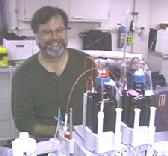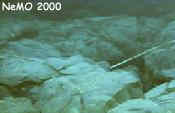| |
Participant
Interview:
Jim Gendron
Chemist
NOAA/PMEL Vents Program
Jeff: Why would a chemist
such as yourself be interested in volcanic activity at Axial Volcano?
Jim: We know the composition of the ocean. The big-picture question relates
to the input of material from rivers and the outputs in sediments. We're
ultimately trying to figure out if they match. Until the discovery of
hydrothermal vents, they didn't match. The better you estimate the inputs
and outputs from vents, the better you can characterize the global mass
balance of materials. This is an ongoing study. I'm interested in what
Axial's producing chemically and trying to characterize both the fluids
and the particulates from vents. I'm investigating how they form and once
they become a plume, I'd like to know the impact of those materials on
global chemical budgets. An important material in ocean water is phosphate
because it's a nutrient. Vent emissions, especially the iron oxides, remove
phosphate from the water column. Therefore, iron is a sink for that important
nutrient. That's one of the major impacts the vents have on the ocean.
Jeff: How have the plumes
at Axial changed since the 1998 eruption.
Jim: When we first came out here in February 1998, a month after the eruption,
the plume containing iron was gigantic. A year later, September 1999,
the plume was much smaller. Often these event plumes are separated from
the vents. We call them a megaplume event cloud. When we came out in February
1998 that wasn't the case. We saw the normal chronic high temperature
venting but didn't find a detached mushroom shaped megaplume.
Jeff: You've been an oceanographer
for quite some time and this is your last cruise. How's it feel?
Jim: I've been a chemical oceanographer for 20 years and this is about
my 50th cruise. It's very rewarding but I think it's time to stop going
to sea. It's something that's hard to put into words. You do it because
you enjoy it. It's interesting. One of the most memorable cruises I've
been on wasn't a Vents related cruise. It was a six week cruise on a Russian
vessel. We left Hilo, Hawaii, went to Kamchatka in Russia and then down
to New Zealand. Besides the chemistry, relating to the people from the
different cultures made it a very interesting cruise. That was the highlight
for me.
|
|

Jim Gendron at work in the
main lab aboard the Ron Brown.

Mooring cable from an MTR which was overrun by the 1998 lava flow. (Mooring
was never recovered.)
|
|

